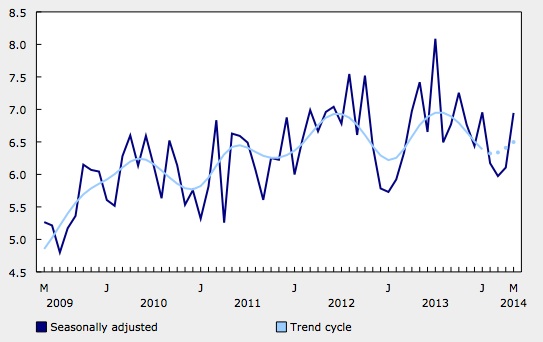
Features
Business intelligence
Contracting
StatsCan building permits report: May 2014
July 10, 2014 By Stats Canada
 July 10, 2014 – Municipalities issued building permits worth $6.9 billion in May,
July 10, 2014 – Municipalities issued building permits worth $6.9 billion in May,
up 13.8 per cent from April. This followed a 2.2 per cent rise in the previous month.
The increase in May resulted primarily from higher construction
intentions for commercial buildings in Ontario and Manitoba, as well as
multi-family dwellings in British Columbia. The total value of permits
has been on a slight upward trend since the beginning of 2014.
 July 10, 2014 – Municipalities issued building permits worth $6.9 billion in May,
July 10, 2014 – Municipalities issued building permits worth $6.9 billion in May,
up 13.8 per cent from April. This followed a 2.2 per cent rise in the previous month.
The increase in May resulted primarily from higher construction
intentions for commercial buildings in Ontario and Manitoba, as well as
multi-family dwellings in British Columbia. The total value of permits
has been on a slight upward trend since the beginning of 2014.
Gains were posted in every province in May, except Quebec and Nova
Scotia. Ontario, British Columbia and Manitoba registered the largest
increases.
Construction intentions for residential dwellings rose 9.5 per cent to
$4.1 billion in May, the third consecutive monthly increase. Higher
residential construction intentions were registered in eight provinces,
led by British Columbia, followed by Ontario and the other western
provinces. Nova Scotia posted the largest decline following two
consecutive monthly gains.
In the non-residential sector, the value of permits rose 20.8 per cent to
$2.8 billion. Gains were posted in seven provinces, led by Ontario and
Manitoba. Quebec, Saskatchewan and Nova Scotia posted declines following
large increases in all three provinces in April.
Residential sector: Higher construction intentions in both multi-family and single-family dwellings
Construction intentions for multi-family dwellings rose 16.1 per cent to
$1.9 billion in May, a third consecutive monthly advance. Higher
construction intentions for apartments and apartments-condominium
projects in British Columbia and, to a lesser extent, Alberta, Manitoba
and Saskatchewan contributed to this gain. Nova Scotia, Quebec and
Prince Edward Island posted declines.
The value of building permits for single-family dwellings rose 4.6 per cent
to $2.3 billion in May. This was the second consecutive monthly
increase. Advances were posted in eight provinces, with Ontario
recording the largest gain. British Columbia and Saskatchewan registered
declines.
Canadian municipalities approved the construction of 17,415 new
dwellings in May, up 11.8 per cent from April. This increase was mostly
attributable to multi-family dwellings, which rose 17.3%
to 11,330 units. The number of single-family dwellings increased 2.8 per cent
to 6,085 units.
Non-residential sector: Significant rise in the commercial component
In May, the value of non-residential building permits registered its
largest monthly gain since July 2013. This advance resulted from a
strong increase in construction intentions for commercial buildings.
Construction intentions for commercial buildings rose 39.4 per cent to
$1.8 billion, the highest level so far in 2014. The advance came from
higher construction intentions in a variety of commercial buildings,
including warehouses, retail complexes, recreational facilities as well
as hotels and restaurants. Gains were posted in nine provinces, with
Ontario and Manitoba registering the largest advances.
In the industrial component, the value of permits rose 22.4 per cent to
$441 million. The increase was largely attributable to higher
construction intentions for manufacturing plants in Quebec and Alberta,
as well as primary industry buildings in British Columbia. Declines were
registered in three provinces, with Ontario posting the largest
decrease.
In the institutional component, the value of permits fell 16.6 per cent to
$555 million. This followed a 37.5 per cent increase in April. The value of
institutional building permits was down in five provinces. The decrease
in May resulted from lower construction intentions for government
buildings in Quebec and medical facilities in Saskatchewan. Alberta and
British Columbia recorded large increases, as a result of higher
construction intentions for educational institutions.
Provinces: Ontario posts the largest advance
The total value of permits was up in eight provinces in May, led by Ontario, followed by British Columbia and Manitoba.
Ontario posted substantial increases in commercial and single-family construction intentions.
The increase in British Columbia was mostly the result of higher
construction intentions for multi-family dwellings and non-residential
buildings. Gains in commercial buildings and multi-family dwellings led
the increase in Manitoba.
In contrast, the decline in Quebec was the result of lower
construction intentions for institutional buildings and multi-family
dwellings.
Higher construction intentions in most census metropolitan areas
Construction intentions were up in 23 of Canada's 34 census metropolitan areas in May.
The largest increases were in Toronto, followed by Vancouver and
Winnipeg. In Toronto, the advance was largely attributable to commercial
buildings and multi-family dwellings. The gain in Vancouver was mainly
the result of higher construction intentions for multi-family dwellings,
whereas in Winnipeg, the increase came from commercial buildings.
In contrast, London, Hamilton and Québec posted the largest declines
in the total value of building permits. Lower construction intentions in
all components, except single-family dwellings, were the reason for the
decrease in London. In Hamilton, the decline originated from
institutional buildings and multi-family dwellings, while in Québec,
commercial buildings were mainly responsible for the decrease.
For more information
Print this page